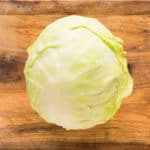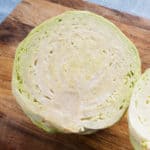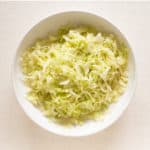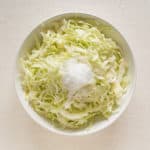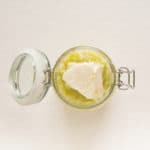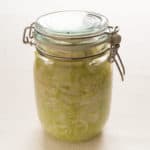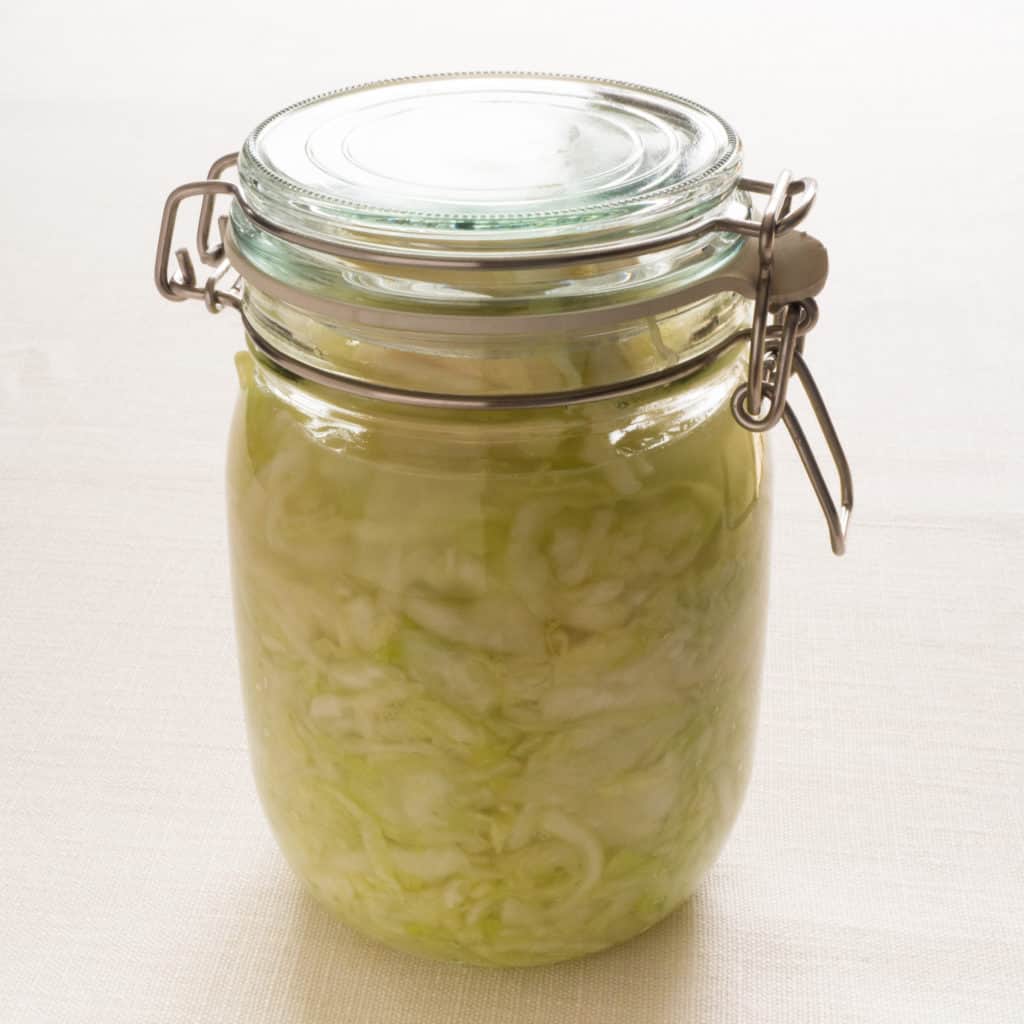
Sauerkraut love!!! Naturally gluten-free and vegan Sauerkraut is all about the seasonal, the preserving, and ultimately, the taste. Sauerkraut is a lacto-fermented vegetable and has a wonderful taste that is hard to describe; tangy, umami, earthy, light and only slightly salty. Much underused, mocked and maligned Sauerkraut is great not only as an accompaniment or sandwich topper but as an ingredient in stir fries, stews and salads (especially if you don’t eat onions or garlic). It is a wonderful complex flavour that is so easy to create, at home and at low cost.
Sauerkraut quick and easy to make with only two ingredient and will be ready to eat in as little as three days.
Perfect on its own as a side, in sandwiches or as a surprise ingredient in almost any dish. Serve with Tofu and Green Peppers in Black Bean Sauce, Gluten Free, Vegan Quiche or add to Healthy, Gluten Free, Vegan, Ginger Tofu at step 5.
There are lots and lots of fermenting and pickle recipes around and you may well have a great, family recipe that works for you. I like this recipe for its simplicity of ingredients and method. If you want to know more about fermenting and preserving I can highly recommend The Art of Fermentation by Sandor Ellix Katz. A wonderful book packed full of knowledge, passion and information (but not recipes as we know them). This book was my inspiration to try out different methods of preserving on the world of fruits and vegetables.
Allergy Information
Sauerkraut is celery free, coconut free, garlic free, gluten free, lupin free, mustard free, nightshade free, onion free, peanut free, sesame free, soya free, tree nut free, vegan.
Top Tips
Sterilise jars in the dishwasher and be careful when removing the jars from the dishwasher and handling them not to touch the inside of the jars to keep them sterile. You must make sure everything is scrupulously clean; utensils, chopping boards, hands and so on. Any dirt, soap or grease may inhibit the fermentation process.
A word on salt. I use sea salt flakes which take up more volume than sea salt crystals and salt grains. This is why I measure salt by weight.
Most recipes use caraway seeds and/ or black peppercorns. Whilst I do love these ingredients I make this version as, without the caraway or pepper flavour, it is so versatile and can be used in almost any dish of any origin. It can be used in place of onion and garlic in stir fries and casseroles. However, you can add whatever spices you like – I am a big fan of hot chilli flakes!!!
You will need to monitor the jars carefully, certainly over the first few weeks, as the fermentation begins, gas will be produced by the process so you will need to release the jars frequently (quite how often varies). Instead of sealing the jars you can use cloth, coffee filters etc. to keep out dust, flies, etc. and allow fermentation to continue without the possibility of exploding jars!!! Your choice.
During the fermentation process you are very likely to see bubbles coming through the cabbage, foam on the top, or white scum – all signs of a healthy, happy fermentation process. The scum can be skimmed off the top either during fermentation or before refrigerating. If you see any mould, do not panic, skim it off and make sure your cabbage is fully submerged. Do not eat mouldy parts close to the surface, remove them, the rest of the sauerkraut will be fine.
Sauerkraut will store for months (and months) and over the first few weeks will get softer. You can enjoy Sauerkraut from just a few days after storing. You can store sauerkraut for several months: it will keep for at least two months at room temperature and longer if kept in the fridge. If it smells good and tastes good – it is good.
You can apply this technique to almost any vegetable (darker greens tend to be more… pungent… perhaps an acquired taste). Root vegetables tend to ferment well (carrot and radishes in particular) and I adore preserved cauliflower. You can also add herbs and spices to your taste, dill, chillies etc. Experiment and see what works for you.
Recipe Information – Sauerkraut
Difficulty easy
Serves 1 large jar (~ 1.2 litre capacity)
Preparation time 20 minutes
Cooking time 0 minutes – waiting time to eat is as little as three days
Ingredients
1 large head (~1 kilogram) white/ green cabbage
4 tablespoons (~60 grams) sea salt
Method
1. Once you have made sure everything is clean remove the wilted, damaged outer leaves from the cabbage, quarter, core and thinly slice the cabbage into very thin ribbons
2. In a large bowl mix the cabbage and salt and work the salt into the cabbage by massaging and squeezing the cabbage with your hands. It might not seem like enough salt, at first, but gradually the cabbage will become watery and limp. This will take five to 10 minutes
3. Pack the cabbage into the sterilised jar(s). There is not pretty way to do this! Take handfuls of the cabbage and press and pack them into the jar. Tamp down the cabbage in the jar with your fist. Once the jar is full add any liquid released by the cabbage into the large bowl whilst massaging it
4. To keep the sauerkraut submerged take one of the larger outer leaves of the cabbage, fold it and place it on the surface of the sliced cabbage. You can remove this once the process is well underway and the sauerkraut does not float to the surface. If the jar is not packed enough or does not keep the cabbage submerged you can also use a plastic cage (from an old pickle jar) or any clean weight
5. To cover the jar: you can either use the jar lid (but you must release this frequently to prevent pressure build up) or cover the mouth of the jar with a cloth or coffee filter and secure it with a rubber band or twine
6. Over the next 24 hours press the cabbage down in the jar every few hours. The cabbage will releases liquid and become more limp and compact. The liquid will rise over the top of the cabbage
7. If after 24 hours, the liquid does not cover cabbage, dissolve 1 teaspoon of salt in 1 cup of boiled and cooled water and add enough to submerge the cabbage
8. Ferment the cabbage for three to 10 days. Keep the Sauerkraut in a cool room (18-22 C). Check it daily and press it down if the cabbage is floating above the liquid
9. Try the sauerkraut after three days and if it tastes good remove the top cabbage leaf and weight and screw on the cap. It can then be refrigerated. You can allow the sauerkraut to continue fermenting for 10 days or even longer. The beauty of fermenting is that you are the judge and if it tastes good to you it is done!
10. Serve with almost anything!
